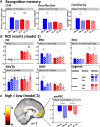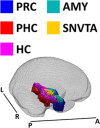Category-specific memory encoding in the medial temporal lobe and beyond: the role of reward
- PMID: 36180131
- PMCID: PMC9536755
- DOI: 10.1101/lm.053558.121
Category-specific memory encoding in the medial temporal lobe and beyond: the role of reward
Abstract
The medial temporal lobe (MTL), including the hippocampus (HC), perirhinal cortex (PRC), and parahippocampal cortex (PHC), is central to memory formation. Reward enhances memory through interplay between the HC and substantia nigra/ventral tegmental area (SNVTA). While the SNVTA also innervates the MTL cortex and amygdala (AMY), their role in reward-enhanced memory is unclear. Prior research suggests category specificity in the MTL cortex, with the PRC and PHC processing object and scene memory, respectively. It is unknown, however, whether reward modulates category-specific memory processes. Furthermore, no study has demonstrated clear category specificity in the MTL for encoding processes contributing to subsequent recognition memory. To address these questions, we had 39 healthy volunteers (27 for all memory-based analyses) undergo functional magnetic resonance imaging while performing an incidental encoding task pairing objects or scenes with high or low reward, followed by a next-day recognition test. Behaviorally, high reward preferably enhanced object memory. Neural activity in the PRC and PHC reflected successful encoding of objects and scenes, respectively. Importantly, AMY encoding effects were selective for high-reward objects, with a similar pattern in the PRC. The SNVTA and HC showed no clear evidence of successful encoding. This behavioral and neural asymmetry may be conveyed through an anterior-temporal memory system, including the AMY and PRC, potentially in interplay with the ventromedial prefrontal cortex.
© 2022 Schultz et al.; Published by Cold Spring Harbor Laboratory Press.
Figures



References
MeSH terms
LinkOut - more resources
Full Text Sources
